In such problems, a set of 6, 7, 8 or 9 numbered figures are given. The candidate is asked t analyse the nature of these figures and classify them into groups consisting of figures having the same properties. Following examples will classify:
Example 1: Group the following figures into three classes with identical properties and select the correct alternative

(a) 1,5,8;2,4,7;3,6,9
(b) 1,4,7;2,5,8;3,6,9
(c) 1,5,7;2,4,9;3,6,8
(d) 1,5,7;3,4,9;2,6,8
Solution: Here, figures 1, 5, 7 contain similar properties. Fig.2, 4 and 9 are similar as they are made of four straight lines. Similarly, Figures 3, 6, and 9 contain a circle as a base.
Hence, (c) in the answer.
Example 2: Group the following figures into three classes with identical properties and select the correct alternative.

(a) 1,2,3;6,5,4;7,9,8
(b) 1,6,7;2,5,9;3,4,8
(c) 1,6,7;2,5,8;3,4,9
(d) 1,3,7;2,5,9;4,6,8.
Solution: Here, we observe that the figure 1,6,7 have only elements, the figures 2,5 and 9 have two elements while figures 3,4 and 8 consist of three elements.
Hence, (b) is the correct alternative.
Example 3. Group the following figures with identical properties into three classes and select the correct alternative.

(a) 1,4,6;3,5,8;2,7,9
(b) 1,4,8;2,3,6;5,7,9
(c) 4,5,6;2,3,8;1,7,9
(d) 1,4,6;2,3,8;5,7,9
Solution: Clearly, in figures 1, 4, 6, two similar figures intersect each other. In figures 2, 3, 8, two dissimilar figures intersect each other. In rest of the figures, i.e., in 5, 7, 9 one similar figure in enclosed into another similar figure.
Hence, (d) is the answer.
Grouping of Images Questions from Previous Year Exams.
Quiz-summary
0 of 15 questions completed
Questions:
- 1
- 2
- 3
- 4
- 5
- 6
- 7
- 8
- 9
- 10
- 11
- 12
- 13
- 14
- 15
Information
Grouping of Images
You have already completed the quiz before. Hence you can not start it again.
Quiz is loading...
You must sign in or sign up to start the quiz.
You have to finish following quiz, to start this quiz:
Results
0 of 15 questions answered correctly
Your time:
Time has elapsed
You have reached 0 of 0 points, (0)
| Average score |
|
| Your score |
|
Categories
- Not categorized 0%
- 1
- 2
- 3
- 4
- 5
- 6
- 7
- 8
- 9
- 10
- 11
- 12
- 13
- 14
- 15
- Answered
- Review
-
Question 1 of 15
1. Question
1 pointsIn each of the following questions, group the given figures into three classes using each figure only once.
Group the given figures into three classes using each figure only once.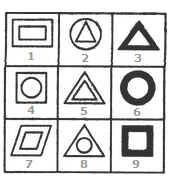 Correct
Correct
1, 5, 7 have two similar elements, one inside the other.
2, 4, 8 have one element placed inside a different element.
3, 6, 9 have two similar elements, one inside the other and the area between the two elements is shaded.
Incorrect
1, 5, 7 have two similar elements, one inside the other.
2, 4, 8 have one element placed inside a different element.
3, 6, 9 have two similar elements, one inside the other and the area between the two elements is shaded.
-
Question 2 of 15
2. Question
1 pointsGroup the given figures into three classes using each figure only once.
 Correct
Correct
1, 3 contain a V-shaped element inside a geometrical figure.
2, 4, 5 contain two similar elements, one placed inside the other and touching it.
6, 7 contain geometrical figures which are divided into four equal parts by two mutually perpendicular straight lines.
Incorrect
1, 3 contain a V-shaped element inside a geometrical figure.
2, 4, 5 contain two similar elements, one placed inside the other and touching it.
6, 7 contain geometrical figures which are divided into four equal parts by two mutually perpendicular straight lines.
-
Question 3 of 15
3. Question
1 pointsGroup the given figures into three classes using each figure only once.
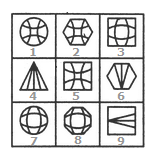 Correct
Correct
1, 2, 5 are figures that have patterns formed from four lines curved in a concave direction.
3, 7, 8 are figures that have patterns formed from four lines curved in a convex direction.
4, 6, 9 are figures that have patterns formed from these straight lines.
Incorrect
1, 2, 5 are figures that have patterns formed from four lines curved in a concave direction.
3, 7, 8 are figures that have patterns formed from four lines curved in a convex direction.
4, 6, 9 are figures that have patterns formed from these straight lines.
-
Question 4 of 15
4. Question
1 pointsGroup the given figures into three classes using each figure only once.
 Correct
Correct
1, 5, 7 contain a rectangle with its two diagonals as the outer element and another element (similar or different) placed inside it.
2, 6, 9 contain a triangle with its three medians as the outer element and another element (similar or different) placed inside it.
3, 4, 8 contain a circle with its two mutually perpendicular diameters as the outer element and another element (similar or different) placed inside it.
Incorrect
1, 5, 7 contain a rectangle with its two diagonals as the outer element and another element (similar or different) placed inside it.
2, 6, 9 contain a triangle with its three medians as the outer element and another element (similar or different) placed inside it.
3, 4, 8 contain a circle with its two mutually perpendicular diameters as the outer element and another element (similar or different) placed inside it.
-
Question 5 of 15
5. Question
1 pointsGroup the given figures into three classes using each figure only once.
 Correct
Correct
1, 3, 5 are figures having partially or completely curved boundaries.
2, 6, 8 are all triangles.
4, 7, 9 are all quadrilateral
Incorrect
1, 3, 5 are figures having partially or completely curved boundaries.
2, 6, 8 are all triangles.
4, 7, 9 are all quadrilateral
-
Question 6 of 15
6. Question
1 pointsGroup the given figures into three classes using each figure only once.
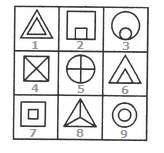 Correct
Correct
1, 7, 9 contain two similar elements one inside the other but not touching each other.
2, 3, 6 contain two similar elements one inside the other and both touching each other.
4, 5, 8 are divided into equal parts by straight lines emerging from the centre.
Incorrect
1, 7, 9 contain two similar elements one inside the other but not touching each other.
2, 3, 6 contain two similar elements one inside the other and both touching each other.
4, 5, 8 are divided into equal parts by straight lines emerging from the centre.
-
Question 7 of 15
7. Question
1 pointsGroup the given figures into three classes using each figure only once.
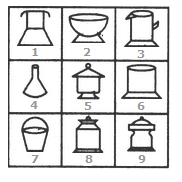 Correct
Correct
5, 8, 9 are objects having both base as well as upper lid.
2, 3, 6 are objects having base but not upper lid.
1, 4, 7 tare objects which have neither a base nor an upper lid attached to them.
Incorrect
5, 8, 9 are objects having both base as well as upper lid.
2, 3, 6 are objects having base but not upper lid.
1, 4, 7 tare objects which have neither a base nor an upper lid attached to them.
-
Question 8 of 15
8. Question
1 pointsGroup the given figures into three classes using each figure only once.
 Correct
Correct
3, 6, 9 are geometrical figures containing line segments (the number of these line segments is half the number of sides in the figure) parallel to the sides of the figure.
1, 5, 8 consist of a circle and a triangle intersecting it. The triangle is also divided into two equal parts by a straight line.
2, 4, 7 are all funnel shaped figures.
Incorrect
3, 6, 9 are geometrical figures containing line segments (the number of these line segments is half the number of sides in the figure) parallel to the sides of the figure.
1, 5, 8 consist of a circle and a triangle intersecting it. The triangle is also divided into two equal parts by a straight line.
2, 4, 7 are all funnel shaped figures.
-
Question 9 of 15
9. Question
1 pointsGroup the given figures into three classes using each figure only once.
 Correct
Correct
1, 6, 9 are figures which are half shaded by slanting lines.
2, 4, 7 are all divided into equal parts (either three or four parts) by straight lines and also have a black circle at the centre.
3, 5, 8 have similar designs and have their four corners shaded black.
Incorrect
1, 6, 9 are figures which are half shaded by slanting lines.
2, 4, 7 are all divided into equal parts (either three or four parts) by straight lines and also have a black circle at the centre.
3, 5, 8 have similar designs and have their four corners shaded black.
-
Question 10 of 15
10. Question
1 pointsGroup the given figures into three classes using each figure only once.
 Correct
Correct
3, 5, 8 have similar designs (four leaves placed close to a small circle and forming a symmetrical design at the centre of the figure).
2, 6, 9 have similar designs (three of the corners of the main figure are shaded black and there is a pattern formed around a '+' sign at the centre of the figure).
1, 4, 7 have similar designs (there are four small circles at(the corners of the main figure and there is a wheel shaped element at the centre of the figure).
Incorrect
3, 5, 8 have similar designs (four leaves placed close to a small circle and forming a symmetrical design at the centre of the figure).
2, 6, 9 have similar designs (three of the corners of the main figure are shaded black and there is a pattern formed around a '+' sign at the centre of the figure).
1, 4, 7 have similar designs (there are four small circles at(the corners of the main figure and there is a wheel shaped element at the centre of the figure).
-
Question 11 of 15
11. Question
1 pointsGroup the given figures into three classes using each figure only once.
 Correct
Correct
1, 5, 8 are all open figures bisected by a line segment.
4, 6, 7 are all closed figures touching a line segment.
2, 3, 9 are all closed figures intersected by a line.
Incorrect
1, 5, 8 are all open figures bisected by a line segment.
4, 6, 7 are all closed figures touching a line segment.
2, 3, 9 are all closed figures intersected by a line.
-
Question 12 of 15
12. Question
1 pointsGroup the given figures into three classes using each figure only once.
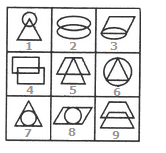 Correct
Correct
2, 4, 9 have two similar elements intersecting each other.
6, 7, 8 have two different elements one placed inside the other.
1, 3, 5 have two different elements intersecting each other.
Incorrect
2, 4, 9 have two similar elements intersecting each other.
6, 7, 8 have two different elements one placed inside the other.
1, 3, 5 have two different elements intersecting each other.
-
Question 13 of 15
13. Question
1 pointsGroup the given figures into three classes using each figure only once.
 Correct
Correct
1, 3, 6 contain one complete circle each.
2, 5, 7 contain a semi-circle each.
4, 8, 9 contain a triangle each.
Incorrect
1, 3, 6 contain one complete circle each.
2, 5, 7 contain a semi-circle each.
4, 8, 9 contain a triangle each.
-
Question 14 of 15
14. Question
1 pointsGroup the given figures into three classes using each figure only once.
 Correct
Correct
1, 7, 8 are all undivided geometrical figures.
3, 5, 6 are geometrical figures divided into two parts.
2, 4, 9 are geometrical figures divided into four parts
Incorrect
1, 7, 8 are all undivided geometrical figures.
3, 5, 6 are geometrical figures divided into two parts.
2, 4, 9 are geometrical figures divided into four parts
-
Question 15 of 15
15. Question
1 pointsGroup the given figures into three classes using each figure only once.
 Correct
Correct
1, 2, 3 are figures composed of two straight lines.
4, 5, 6 are figures composed of three straight lines.
7, 8, 9 are figures composed of four straight lines.
Incorrect
1, 2, 3 are figures composed of two straight lines.
4, 5, 6 are figures composed of three straight lines.
7, 8, 9 are figures composed of four straight lines.

0 Comments